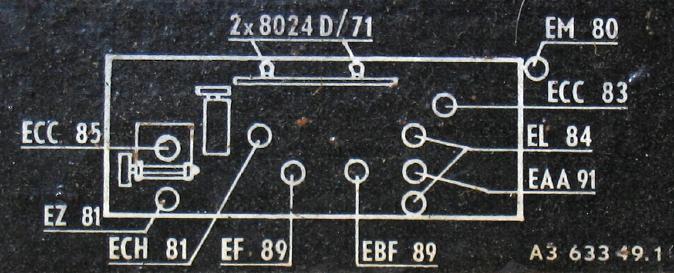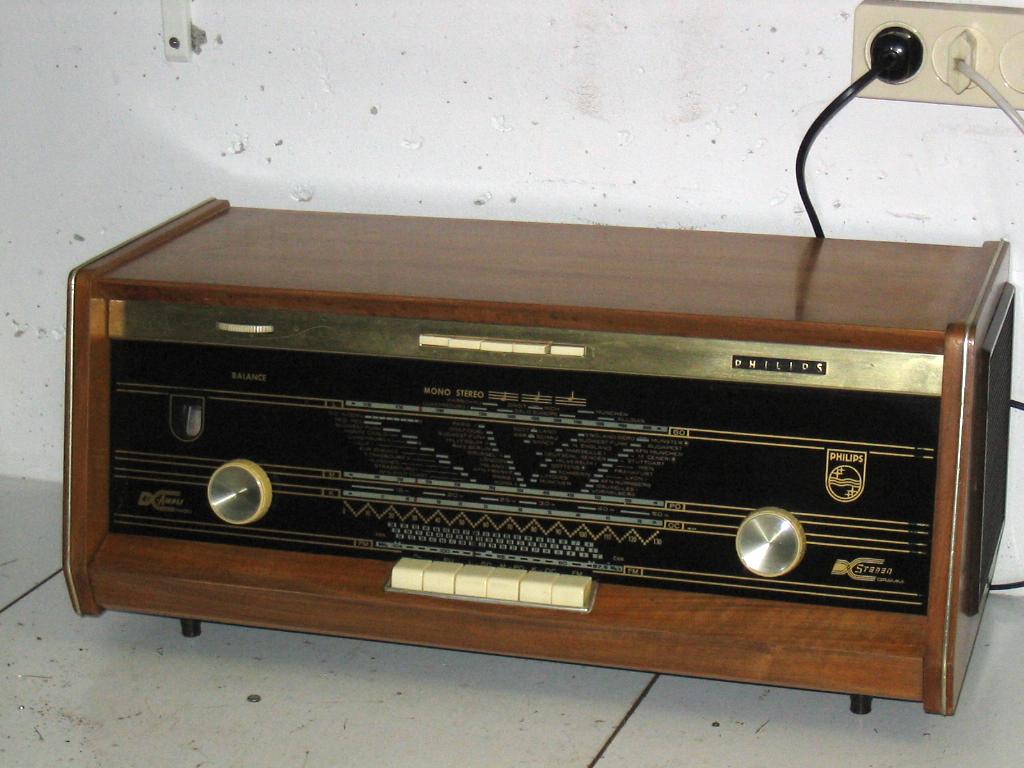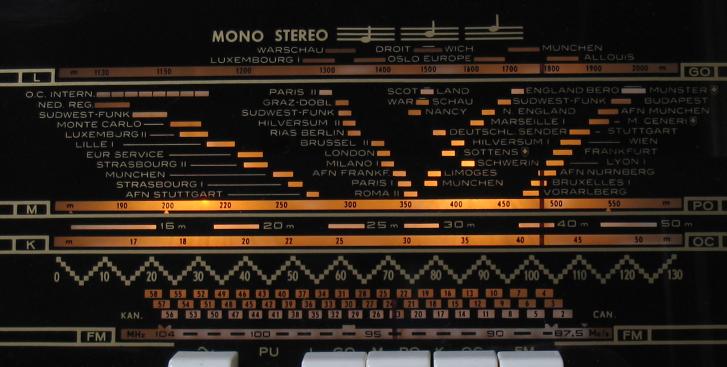
ECC85 (FM tunes), ECH81 (Mixer), EF89 (IF Amp), EBF89 (IF and detector), EAA91 (FM Ratio detector), ECC83 (Audio Preamp), EL84 and EL84 (Output), EZ81 (Rectifier), EM80 (Tuning eye).

252
Item nr.

Philips plano models were universal in the early sixties.
| Production | The Netherlands, 1962. |
|---|---|
| Bands | LW MW SW FM (87.5-104 MHz). |
| Tubes |  ECC85 (FM tunes), ECH81 (Mixer), EF89 (IF Amp), EBF89 (IF and detector), EAA91 (FM Ratio detector), ECC83 (Audio Preamp), EL84 and EL84 (Output), EZ81 (Rectifier), EM80 (Tuning eye). |
| Cabinet | Wood. Size 56x22x24 cm. |
| Power | AC (110-245V), 75W. |
 The FM band coverage differs from model to model, because during the fifties only the lower half of the band (up to 100MHz) was used. So, early planos tuned up to 100MHz, in the sixties they extended up to 104MHz, and only by the end of the sixties, radios ranging up to 108MHz were produced by Philips. Export models are an exception, of course. Notice the symmetry on the dial, with the MW stations arranged in V-shapes. Only the name of the DeutschlandSender was too long, and it had to be placed a bit higher and this disrupts the nice pattern.
The FM band coverage differs from model to model, because during the fifties only the lower half of the band (up to 100MHz) was used. So, early planos tuned up to 100MHz, in the sixties they extended up to 104MHz, and only by the end of the sixties, radios ranging up to 108MHz were produced by Philips. Export models are an exception, of course. Notice the symmetry on the dial, with the MW stations arranged in V-shapes. Only the name of the DeutschlandSender was too long, and it had to be placed a bit higher and this disrupts the nice pattern.
| Obtained | 3/2005 from Jeroen Fokker. |
|---|---|
| Condition | 8. |
| Disposed | Sold 7/2011. |
| Sound sample | PLAY SOUND Fifteen million Dutch people, all individuals, but with a common youth memory: a wood plano playing in Grandma's living room. |
Repairing a plano is usually a pleasure because the layout is sufficiently spaced to allow good reachability with the soldering iron. Just keep in mind that the chassis should be pulled through the front of the cabinet. There are a few common problems:
I refished the cabinet and replaced the ugly power plug. Measurement of the tubes revealed that only the ECH81 and the EZ80 wanted to be replaced; for the EZ80 I put the more powerful EZ81 (Haltron).  There were two nasty technical problems, that I managed to reduce, but not solve. One, there is distortion when loud basses are reproduced. I fixed the loudspeaker spiders which made it less severe, but I think some of the remaining distortion is produced in the electrical circuits. Two, there is some signal loss between the second IF tube for AM (B3, EF89) and the detector (B4). This causes the radio to overload on strong stations. The problem was reduced a lot by disconnecting C48, 100pF, from the detector coil.
There were two nasty technical problems, that I managed to reduce, but not solve. One, there is distortion when loud basses are reproduced. I fixed the loudspeaker spiders which made it less severe, but I think some of the remaining distortion is produced in the electrical circuits. Two, there is some signal loss between the second IF tube for AM (B3, EF89) and the detector (B4). This causes the radio to overload on strong stations. The problem was reduced a lot by disconnecting C48, 100pF, from the detector coil.
I made a memory card with a station list for the radio (right). This is a lot better than sticking stickers to the dial!